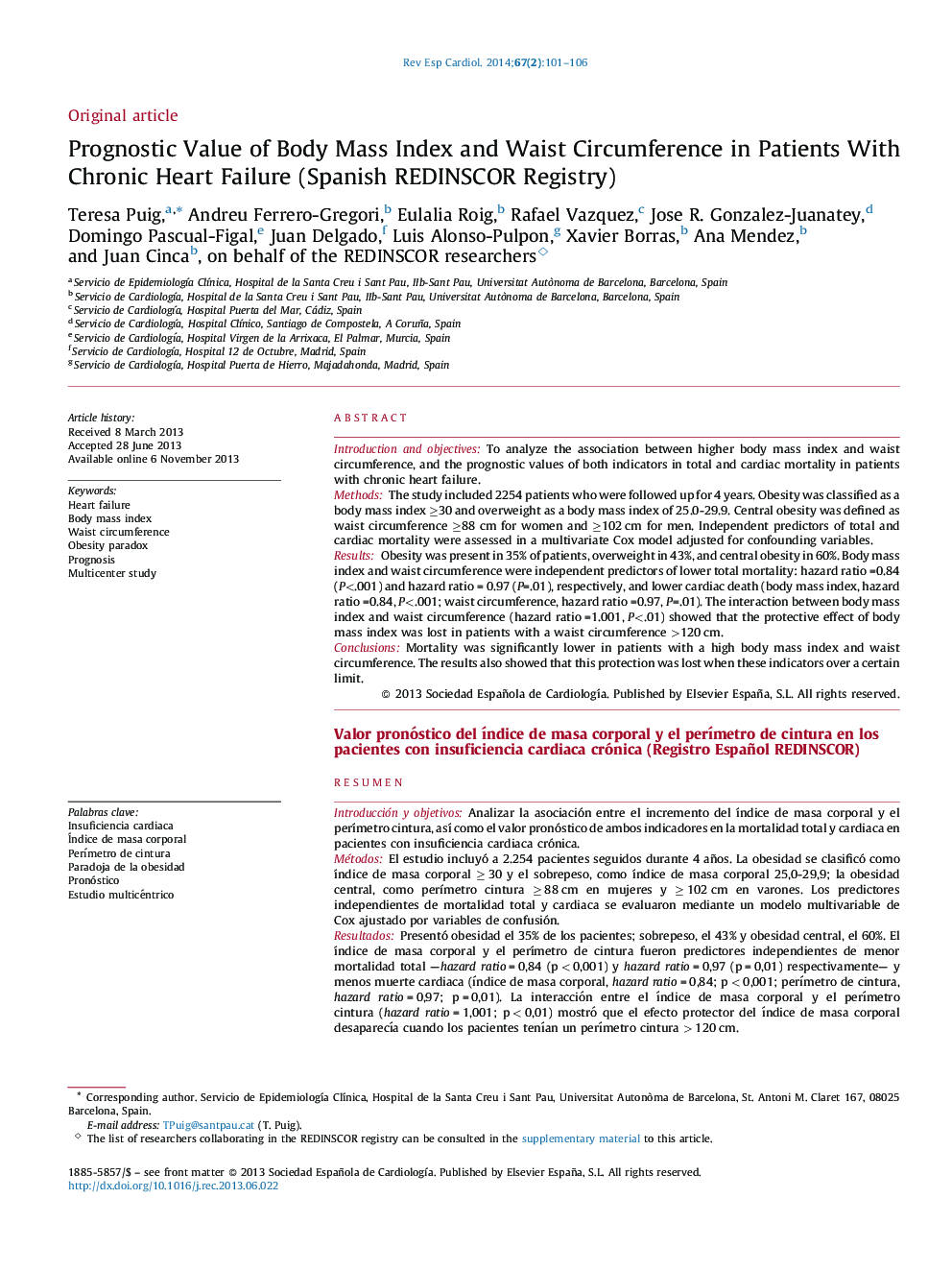| کد مقاله | کد نشریه | سال انتشار | مقاله انگلیسی | نسخه تمام متن |
|---|---|---|---|---|
| 3017459 | 1182120 | 2014 | 6 صفحه PDF | دانلود رایگان |

Introduction and objectivesTo analyze the association between higher body mass index and waist circumference, and the prognostic values of both indicators in total and cardiac mortality in patients with chronic heart failure.MethodsThe study included 2254 patients who were followed up for 4 years. Obesity was classified as a body mass index ≥30 and overweight as a body mass index of 25.0-29.9. Central obesity was defined as waist circumference ≥88 cm for women and ≥102 cm for men. Independent predictors of total and cardiac mortality were assessed in a multivariate Cox model adjusted for confounding variables.ResultsObesity was present in 35% of patients, overweight in 43%, and central obesity in 60%. Body mass index and waist circumference were independent predictors of lower total mortality: hazard ratio =0.84 (P<.001) and hazard ratio = 0.97 (P=.01), respectively, and lower cardiac death (body mass index, hazard ratio =0.84, P<.001; waist circumference, hazard ratio =0.97, P=.01). The interaction between body mass index and waist circumference (hazard ratio =1.001, P<.01) showed that the protective effect of body mass index was lost in patients with a waist circumference >120 cm.ConclusionsMortality was significantly lower in patients with a high body mass index and waist circumference. The results also showed that this protection was lost when these indicators over a certain limit.
ResumenIntroducción y objetivosAnalizar la asociación entre el incremento del índice de masa corporal y el perímetro cintura, así como el valor pronóstico de ambos indicadores en la mortalidad total y cardiaca en pacientes con insuficiencia cardiaca crónica.MétodosEl estudio incluyó a 2.254 pacientes seguidos durante 4 años. La obesidad se clasificó como índice de masa corporal ≥ 30 y el sobrepeso, como índice de masa corporal 25,0-29,9; la obesidad central, como perímetro cintura ≥ 88 cm en mujeres y ≥ 102 cm en varones. Los predictores independientes de mortalidad total y cardiaca se evaluaron mediante un modelo multivariable de Cox ajustado por variables de confusión.ResultadosPresentó obesidad el 35% de los pacientes; sobrepeso, el 43% y obesidad central, el 60%. El índice de masa corporal y el perímetro de cintura fueron predictores independientes de menor mortalidad total —hazard ratio = 0,84 (p < 0,001) y hazard ratio = 0,97 (p = 0,01) respectivamente— y menos muerte cardiaca (índice de masa corporal, hazard ratio = 0,84; p < 0,001; perímetro de cintura, hazard ratio = 0,97; p = 0,01). La interacción entre el índice de masa corporal y el perímetro cintura (hazard ratio = 1,001; p < 0,01) mostró que el efecto protector del índice de masa corporal desaparecía cuando los pacientes tenían un perímetro cintura > 120 cm.ConclusionesSe confirma una mortalidad significativamente menor entre los pacientes que presentan un incremento del índice de masa corporal y del perímetro de cintura. Los resultados muestran además que esta protección desaparece al alcanzar valores elevados.
Journal: Revista Española de Cardiología (English Edition) - Volume 67, Issue 2, February 2014, Pages 101–106